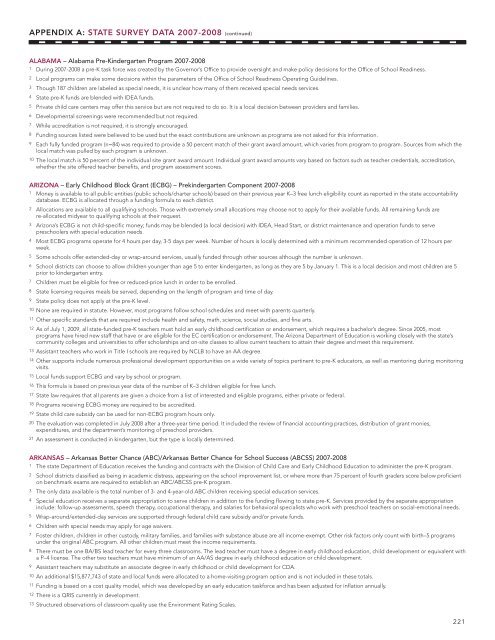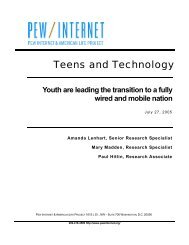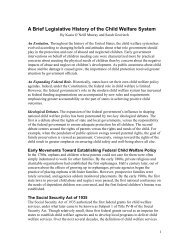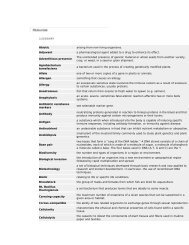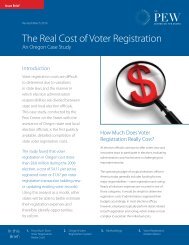Report: The State of Preschool 2008: State Preschool Yearbook
Report: The State of Preschool 2008: State Preschool Yearbook
Report: The State of Preschool 2008: State Preschool Yearbook
Create successful ePaper yourself
Turn your PDF publications into a flip-book with our unique Google optimized e-Paper software.
APPENDIX A: STATE SURVEY DATA 2007-<strong>2008</strong> (continued)<br />
ALABAMA – Alabama Pre-Kindergarten Program 2007-<strong>2008</strong><br />
1 During 2007-<strong>2008</strong> a pre-K task force was created by the Governor’s Office to provide oversight and make policy decisions for the Office <strong>of</strong> School Readiness.<br />
2 Local programs can make some decisions within the parameters <strong>of</strong> the Office <strong>of</strong> School Readiness Operating Guidelines.<br />
3 Though 187 children are labeled as special needs, it is unclear how many <strong>of</strong> them received special needs services.<br />
4 <strong>State</strong> pre-K funds are blended with IDEA funds.<br />
5 Private child care centers may <strong>of</strong>fer this service but are not required to do so. It is a local decision between providers and families.<br />
6 Developmental screenings were recommended but not required.<br />
7 While accreditation is not required, it is strongly encouraged.<br />
8 Funding sources listed were believed to be used but the exact contributions are unknown as programs are not asked for this information.<br />
9 Each fully funded program (n=84) was required to provide a 50 percent match <strong>of</strong> their grant award amount, which varies from program to program. Sources from which the<br />
local match was pulled by each program is unknown.<br />
10 <strong>The</strong> local match is 50 percent <strong>of</strong> the individual site grant award amount. Individual grant award amounts vary based on factors such as teacher credentials, accreditation,<br />
whether the site <strong>of</strong>fered teacher benefits, and program assessment scores.<br />
ARIZONA – Early Childhood Block Grant (ECBG) – Prekindergarten Component 2007-<strong>2008</strong><br />
1 Money is available to all public entities (public schools/charter schools) based on their previous year K–3 free lunch eligibility count as reported in the state accountability<br />
database. ECBG is allocated through a funding formula to each district.<br />
2 Allocations are available to all qualifying schools. Those with extremely small allocations may choose not to apply for their available funds. All remaining funds are<br />
re-allocated midyear to qualifying schools at their request.<br />
3 Arizona’s ECBG is not child-specific money; funds may be blended (a local decision) with IDEA, Head Start, or district maintenance and operation funds to serve<br />
preschoolers with special education needs.<br />
4 Most ECBG programs operate for 4 hours per day, 3-5 days per week. Number <strong>of</strong> hours is locally determined with a minimum recommended operation <strong>of</strong> 12 hours per<br />
week.<br />
5 Some schools <strong>of</strong>fer extended-day or wrap-around services, usually funded through other sources although the number is unknown.<br />
6 School districts can choose to allow children younger than age 5 to enter kindergarten, as long as they are 5 by January 1. This is a local decision and most childrenare5<br />
prior to kindergarten entry.<br />
7 Children must be eligible for free or reduced-price lunch in order to be enrolled.<br />
8 <strong>State</strong> licensing requires meals be served, depending on the length <strong>of</strong> program and time <strong>of</strong> day.<br />
9 <strong>State</strong> policy does not apply at the pre-K level.<br />
10 None are required in statute. However, most programs follow school schedules and meet with parents quarterly.<br />
11 Other specific standards that are required include health and safety, math, science, social studies, and fine arts.<br />
12 As <strong>of</strong> July 1, 2009, all state-funded pre-K teachers must hold an early childhood certification or endorsement, which requires a bachelor’s degree. Since 2005, most<br />
programs have hired new staff that have or are eligible for the EC certification or endorsement. <strong>The</strong> Arizona Department <strong>of</strong> Education is working closely with the state’s<br />
community colleges and universities to <strong>of</strong>fer scholarships and on-site classes to allow current teachers to attain their degree and meet this requirement.<br />
13 Assistant teachers who work in Title I schools are required by NCLB to have an AA degree.<br />
14 Other supports include numerous pr<strong>of</strong>essional development opportunities on a wide variety <strong>of</strong> topics pertinent to pre-K educators, as well as mentoring during monitoring<br />
visits.<br />
15 Local funds support ECBG and vary by school or program.<br />
16 This formula is based on previous year data <strong>of</strong> the number <strong>of</strong> K–3 children eligible for free lunch.<br />
17 <strong>State</strong> law requires that all parents are given a choice from a list <strong>of</strong> interested and eligible programs, either private or federal.<br />
18 Programs receiving ECBG money are required to be accredited.<br />
19 <strong>State</strong> child care subsidy can be used for non-ECBG program hours only.<br />
20 <strong>The</strong> evaluation was completed in July <strong>2008</strong> after a three-year time period. It included the review <strong>of</strong> financial accounting practices, distribution <strong>of</strong> grant monies,<br />
expenditures, and the department’s monitoring <strong>of</strong> preschool providers.<br />
21 An assessment is conducted in kindergarten, but the type is locally determined.<br />
ARKANSAS – Arkansas Better Chance (ABC)/Arkansas Better Chance for School Success (ABCSS) 2007-<strong>2008</strong><br />
1 <strong>The</strong> state Department <strong>of</strong> Education receives the funding and contracts with the Division <strong>of</strong> Child Care and Early Childhood Education to administer the pre-K program.<br />
2 School districts classified as being in academic distress, appearing on the school improvement list, or where more than 75 percent <strong>of</strong> fourth graders score below pr<strong>of</strong>icient<br />
on benchmark exams are required to establish an ABC/ABCSS pre-K program.<br />
3 <strong>The</strong> only data available is the total number <strong>of</strong> 3- and 4-year-old ABC children receiving special education services.<br />
4 Special education receives a separate appropriation to serve children in addition to the funding flowing to state pre-K. Services provided by the separate appropriation<br />
include: follow-up assessments, speech therapy, occupational therapy, and salaries for behavioral specialists who work with preschool teachers on social-emotional needs.<br />
5 Wrap-around/extended-day services are supported through federal child care subsidy and/or private funds.<br />
6 Children with special needs may apply for age waivers.<br />
7 Foster children, children in other custody, military families, and families with substance abuse are all income-exempt. Other risk factors only count with birth–5 programs<br />
under the original ABC program. All other children must meet the income requirements.<br />
8 <strong>The</strong>re must be one BA/BS lead teacher for every three classrooms. <strong>The</strong> lead teacher must have a degree in early childhood education, child development or equivalent with<br />
a P–4 license. <strong>The</strong> other two teachers must have minimum <strong>of</strong> an AA/AS degree in early childhood education or child development.<br />
9 Assistant teachers may substitute an associate degree in early childhood or child development for CDA.<br />
10 An additional $15,877,743 <strong>of</strong> state and local funds were allocated to a home-visiting program option and is not included in these totals.<br />
11 Funding is based on a cost quality model, which was developed by an early education taskforce and has been adjusted for inflation annually.<br />
12 <strong>The</strong>re is a QRIS currently in development.<br />
13 Structured observations <strong>of</strong> classroom quality use the Environment Rating Scales.<br />
221


